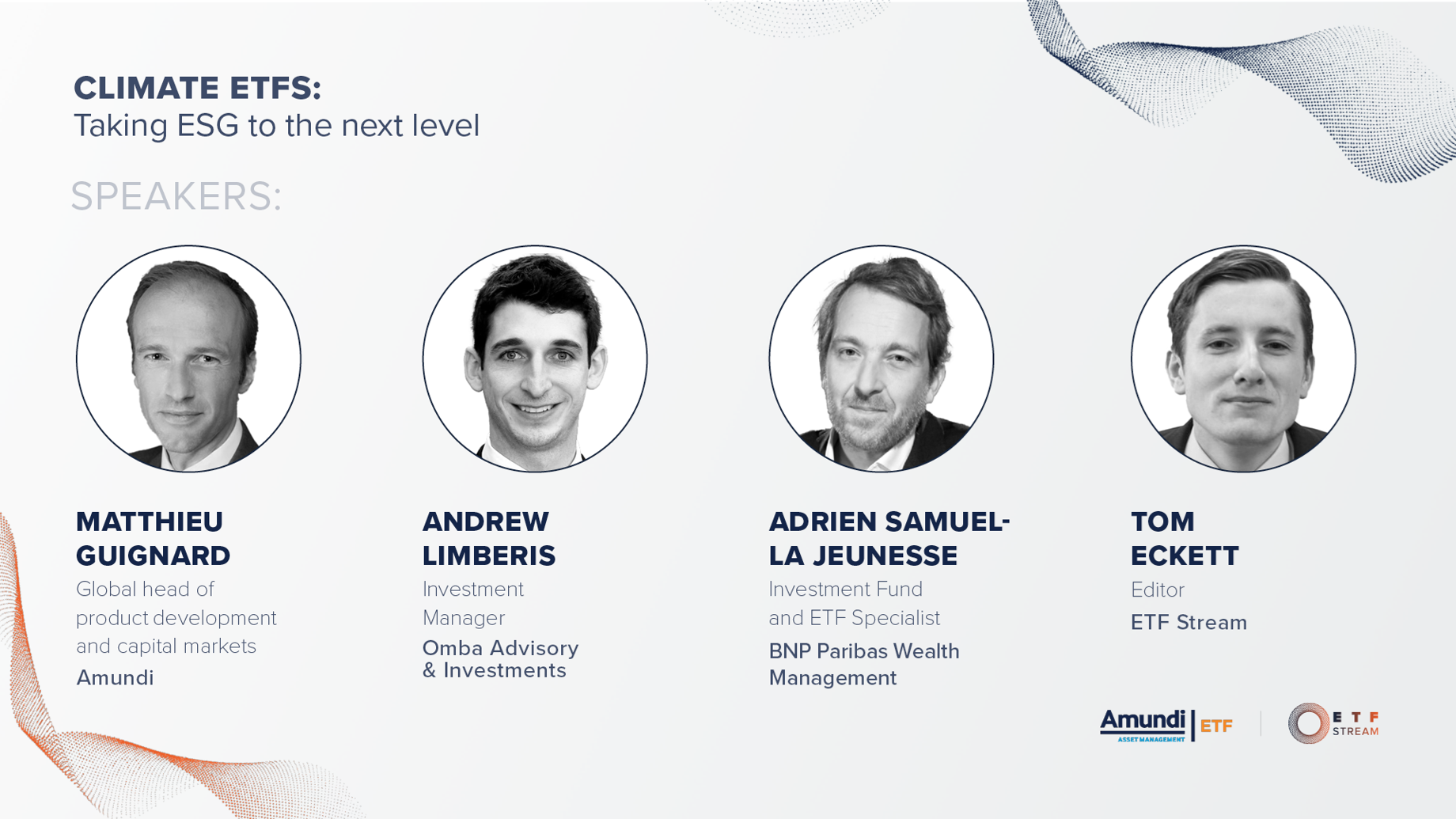The significance of pan-European ESG indices, the role of climate ETFs in portfolio construction and the future of emissions reporting were some of the key areas covered during ETF Stream’s recent ESG ETF webinar in partnership with Amundi.
The webinar, entitled Climate ETFs: Taking ESG to the next level, started by discussing the support for the climate investment theme and the importance of the EU Climate Transition and Paris-Aligned Benchmarks.
Matthieu Guignard, head of product development and capital markets at Amundi, stressed climate considerations are becoming a central consideration in most of the conversations the company has with clients.
Aside from the ethical aspect of climate-focused investing, there is a general understanding that regulation will continue to push towards climate-friendly investment.
Guignard said: “Many investors also see an investment into climate approach as a hedge against some specific risk regarding climate transition or even the physical risks of climate change.”
Adrian Samuel-Lajeunesse, investment fund and ETF specialist at BNP Paribas Wealth Management, added climate-focused investment gives clients a positive portrayal of the work companies are doing.
“It is a great message for us to convey to our clients that our investment can have an impact while having transparency and clear conversation regarding these factors.”
On the EU Climate Transition (CTB) and Paris-Aligned (PAB) Benchmarks, Guignard said that following the 2018 climate action plan, these benchmarks represent a breakthrough moment for unilateral standards on ESG.
“We have had local initiatives in many countries to define ESG labels with different approaches,” Guignard continued. “This is the first pan-European initiative in the ESG field with this climate approach.”
Echoing this sentiment, Andrew Limberis, investment manager at Omba Advisory & Investments, added: “The two benchmarks offer a sustainable investment with a clear objective, and a clear methodology in terms of how they get there, which adds something new to the current ESG investments that are available in the market.”
Limberis said the two benchmarks also highlight the important role index investing has to play in terms of its ability to orient capital flows towards climate-friendly investments going forwards.
Challenges facing climate benchmarking
According to the panel, there are three main considerations that will be key to the relative success of climate benchmarks.
The first is the risk of concentration given the benchmarks have an annual 7% carbon reduction, if a CTB or PAB benchmark were launched on a single country there would be a risk of lack of availability of eligible stocks. For this reason, index providers have been very intentional in creating CTB or PAB indices, to ensure there is sufficient breadth. However, the climate investment approaches will create a virtuous cycle and we anticipate an increase in stocks meeting eligibility criteria over time as more companies pay attention to these issues.
Despite being internationally inclusive and ESG-aligned, benchmarks will face challenges when attempting to expand into new geographies, such as the US, in the future.
While European ESG investment is biased towards climate issues, ESG investment in the US favours social issues such as equality and representation.
Guignard said: “There is still a long way to go to have real common ground, and to have a common approach to those themes.”
A second consideration is around the capacity for engagement. Guignard said engagement has a crucial role to play within ESG ETFs. This role is reinforced within passive strategies versus active strategies as issuers are unable to use divestment as the go-to response to a company’s misdeeds.
“The dialogue we have with the companies is essential to apply pressure company's management, either to change their behaviour or to vote again in specific developments that we believe would be contrary to the principles,” Guignard noted.
Finally, and most importantly, an increasingly nuanced examination of emissions throughout supply chains will require more detailed and accurate data reporting.
Emissions are classified as Scope 1, those directly produced during the manufacturing process, Scope 2, those indirectly incurred by the energy consumption of the manufacturing process, and Scope 3, those indirectly produced at all stages before and after the manufacturing process – during resource extraction, transportation, and disposal.
Guignard said all three scopes are vital in order to capture not just the full array of emissions produced, but likewise, to record the emissions produced by participants at different stages of the supply chain.
The main challenge going forwards is that Scope 3 is a particularly broad category, accounting for more emissions than scopes one and two combined. Adding to this, Limberis stressed just 38% of companies worldwide provide estimates for their Scope 3 emissions while the number of accurate estimations is likely a lower number.
Speaking on Scope 1, 2 and 3 data collection, Limberis continued: “There is still a long way to go in terms of terms of data quality and improving disclosure, but especially in terms of benchmarks.
“By looking at the final companies that are actually held in the benchmark, that is one of the clearest ways you can identify that an investment is achieving your objectives.”
Future role of climate benchmarks
Regarding portfolio allocations in CTB and PAB ETFs, and ESG more broadly, Guignard said these exposures are already being seen as core holdings and this will only increase going forwards, though expansion across different geographies will take time.
Guignard added: “It is going to be a relatively slow process. We have had ESG investments around for a while now and this is not necessarily going to just speed up the adoption, any quicker than what we had already seen.”
Climate change ETFs: What is all the fuss about?
Whether stemming from European regulators or index providers themselves, Limberis expects benchmark methodology to evolve and become more sophisticated – though this will be contingent on advances in data reporting and transparency.
As companies move with the decarbonisation transition, Samuel-Lajeunesse predicted investors will reap the benefits of greater granularity and segmentation.
Another prospect is the use of the CTB and PAB as bases for fixed income strategies. On this, Guignard said fixed income products would use the same constituents as equity strategies tracking these indices, and that the wide array of bond products on offer would make them a good fit for either the CTB and PAB.
Going a step further, Limberis said fixed income makes up a key part of every company’s capital structure, and therefore future climate-friendly benchmarking would be remiss to cover equities alone.
“It would be better if the market as a whole at least has some sort of ESG metric, in which case that would pile further pressure on the company in terms of making environmental decisions,” Limberis concluded.




